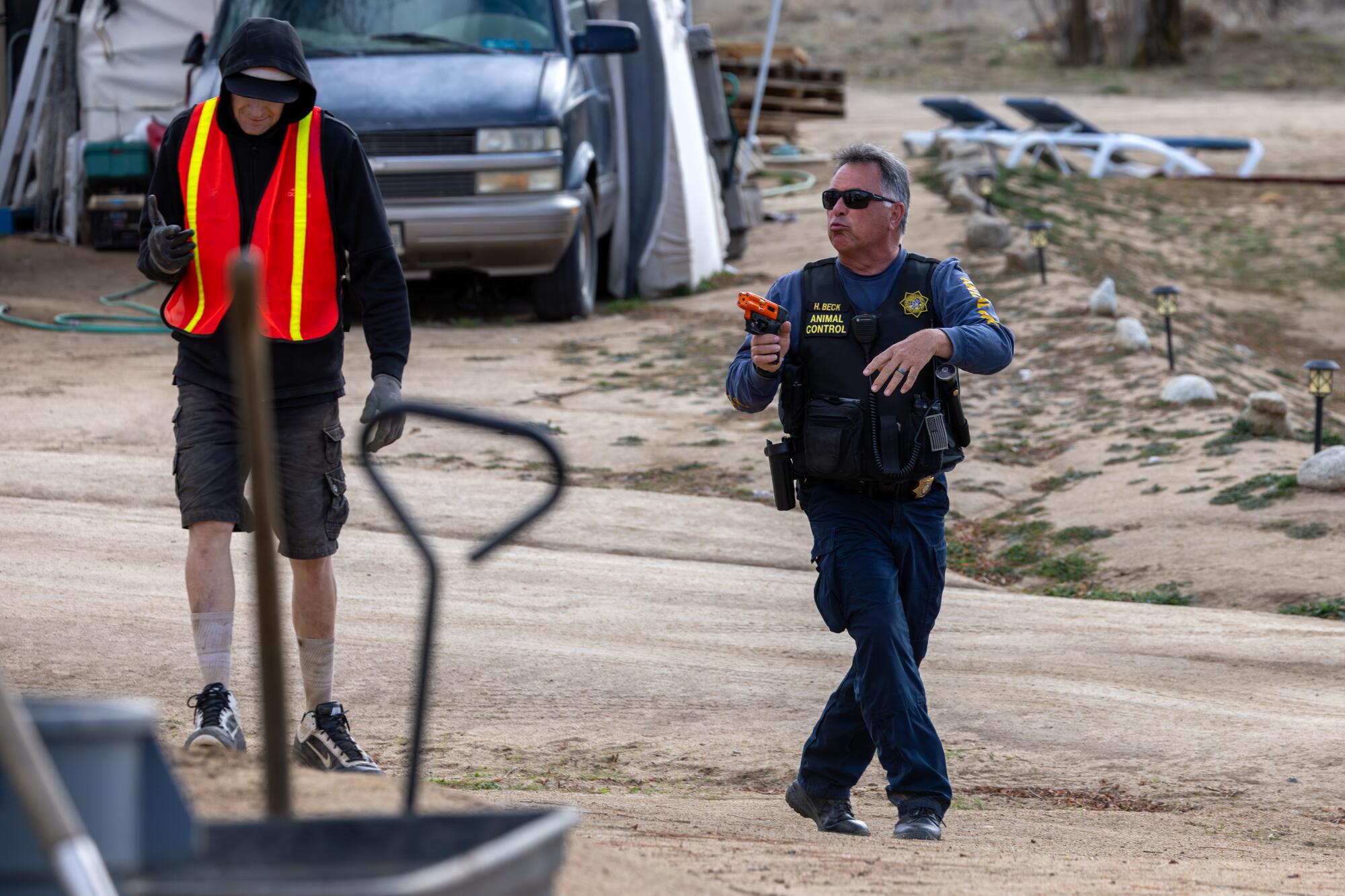
- Share via
Drive down any of the long, rutted back roads of Anza, a dusty Riverside County community, and it won’t take long before you feel like you’ve fallen off the grid.
Telephone poles disappear. Street signs and lights are nowhere to be seen. And ramshackle houses and fences hide behind thickets of weather-beaten manzanita and chaparral.
If you’re quiet, you’ll hear the wind roll across the valley, or maybe the bell-like clink of a sage sparrow in a nearby bush. But if you make a sound, one, two, three or more barking, growling dogs clamber down toward you — dogs that Riverside County animal control officer Harvey Beck says are no joke.
Santa Cruz’s sea otter, 841, has given birth to a wee pup — suggesting that her erratic behavior could have been hormonally driven.
This spring, a pack of free-roaming hounds — identified as three Labrador mixes, two Queensland blue heelers and a husky — slaughtered a herd of goats and two sheep. The bloodbath was documented on Facebook with gut-churning photographs and descriptions.
In 2018, a woman was killed by a pack of canines in broad daylight.
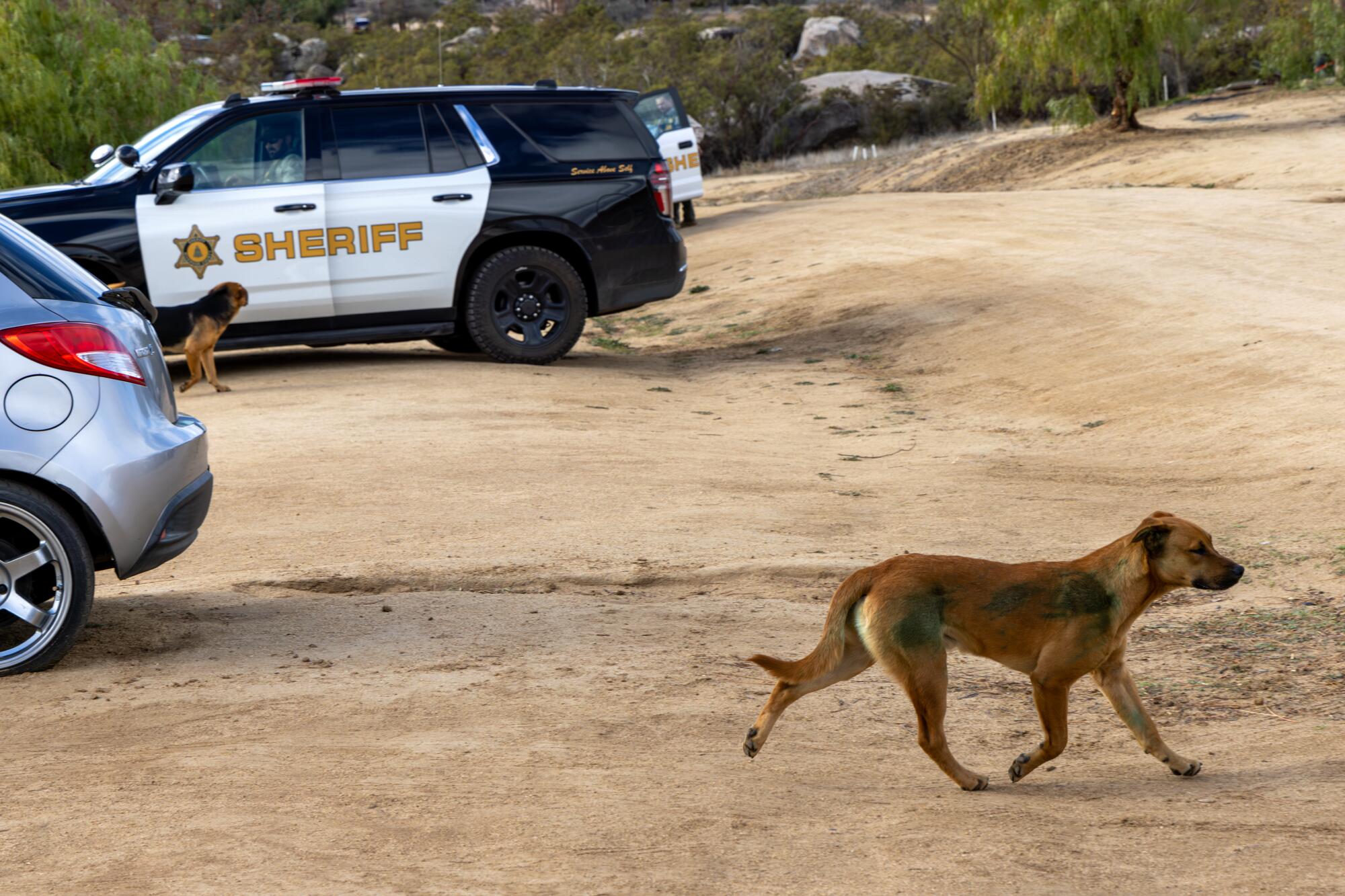
But it’s not the dirty-looking curs that run, snarl, bark and gnash their teeth behind fences when a visitor approaches that one needs to fear. Instead, Beck says, it’s the ones with unfettered access to the outside world that cause concern — the ones that wander in packs, chasing and killing pets, livestock and wildlife.
While the problem is particularly bad in Anza, it’s hardly unique.
According to reports from the U.S. Department of Agriculture’s Wildlife Services, domestic dogs are the second-most lethal predator of livestock, with coyotes taking the top spot.
In the case of sheep, coyotes and dogs account for more than 70% of predator losses, and dog kills are on the rise. In 2014, roughly 13,200 adult sheep were killed by dogs. In 2019, that number had increased by more than 10,000.
For cattle and calves, a 2015 report shows dogs accounted for 11.3% of kills. Wolves killed just 4.9%.
But research on the topic is scarce in the U.S.
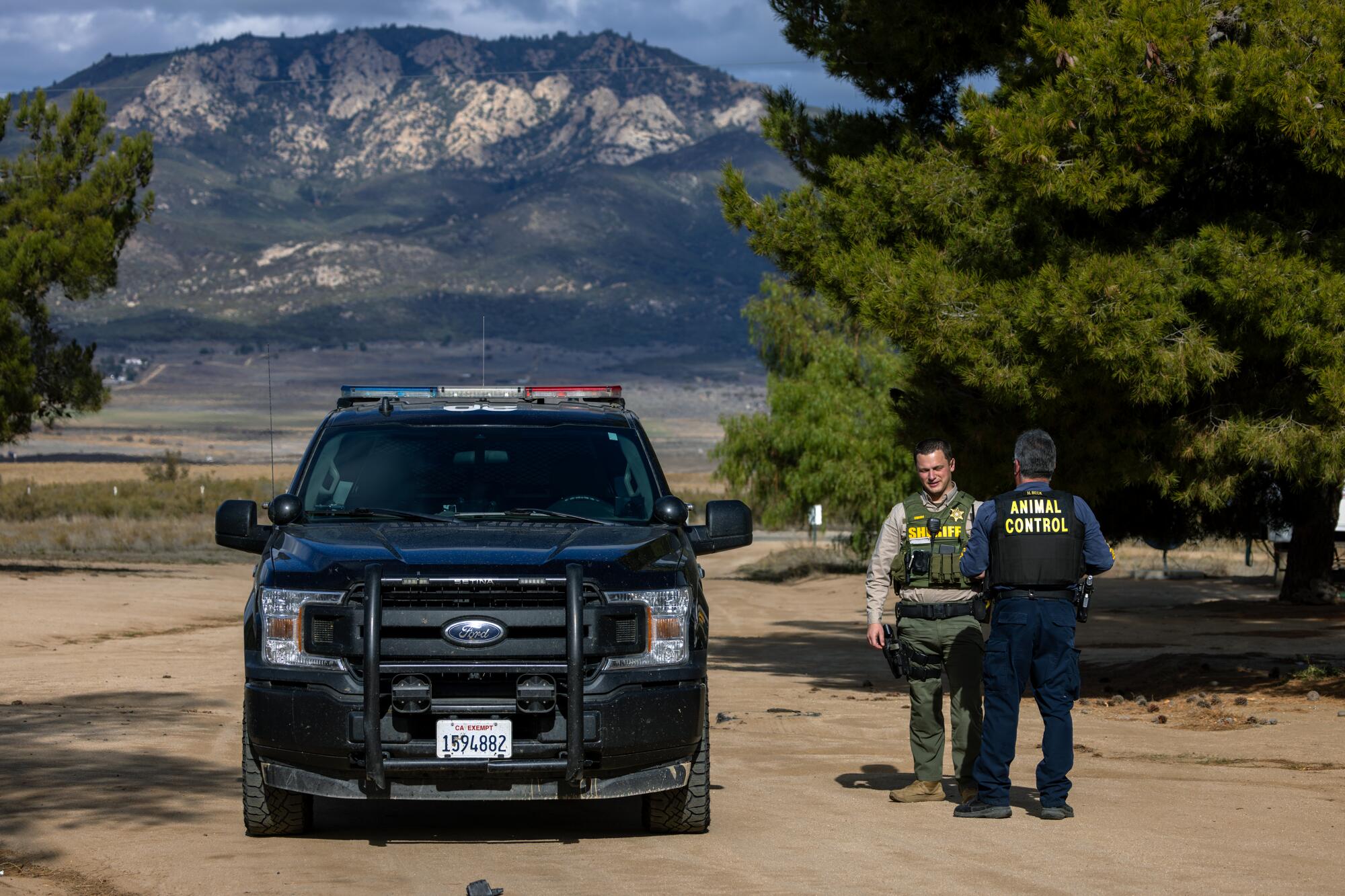
When asked about the problem, a spokeswoman for the USDA said it was hard for wildlife officials to determine whether the dogs are feral, free-roaming or unleashed pets.
Calls to other federal and state wildlife agencies elicited similar responses.
“It’s not something we generally deal with,” said Tim Daly, a California Department of Fish and Wildlife spokesman.
But nongovernment researchers and ranchers say the problem is real and cite the USDA’s numbers, as well as their own research and experience, as evidence.
“I remember my boss saying, ‘Well, we’re in the business of wildlife, we’re not in the business of dogs,’” said Julie Young, an ecologist at Utah State University who worked for the USDA for 12 years. “Our mission was to reduce conflict with wildlife. So, I think there’s this gray area where, you know, who does manage feral and free-roaming dogs? And who shouldn’t be managing it?”
In Riverside County, the Department of Animal Services is working hard to be proactive about the problem: bringing a spay-neuter bus to the region, providing occasional vaccination and educational clinics, and urging people to keep their pets indoors and behind fences.
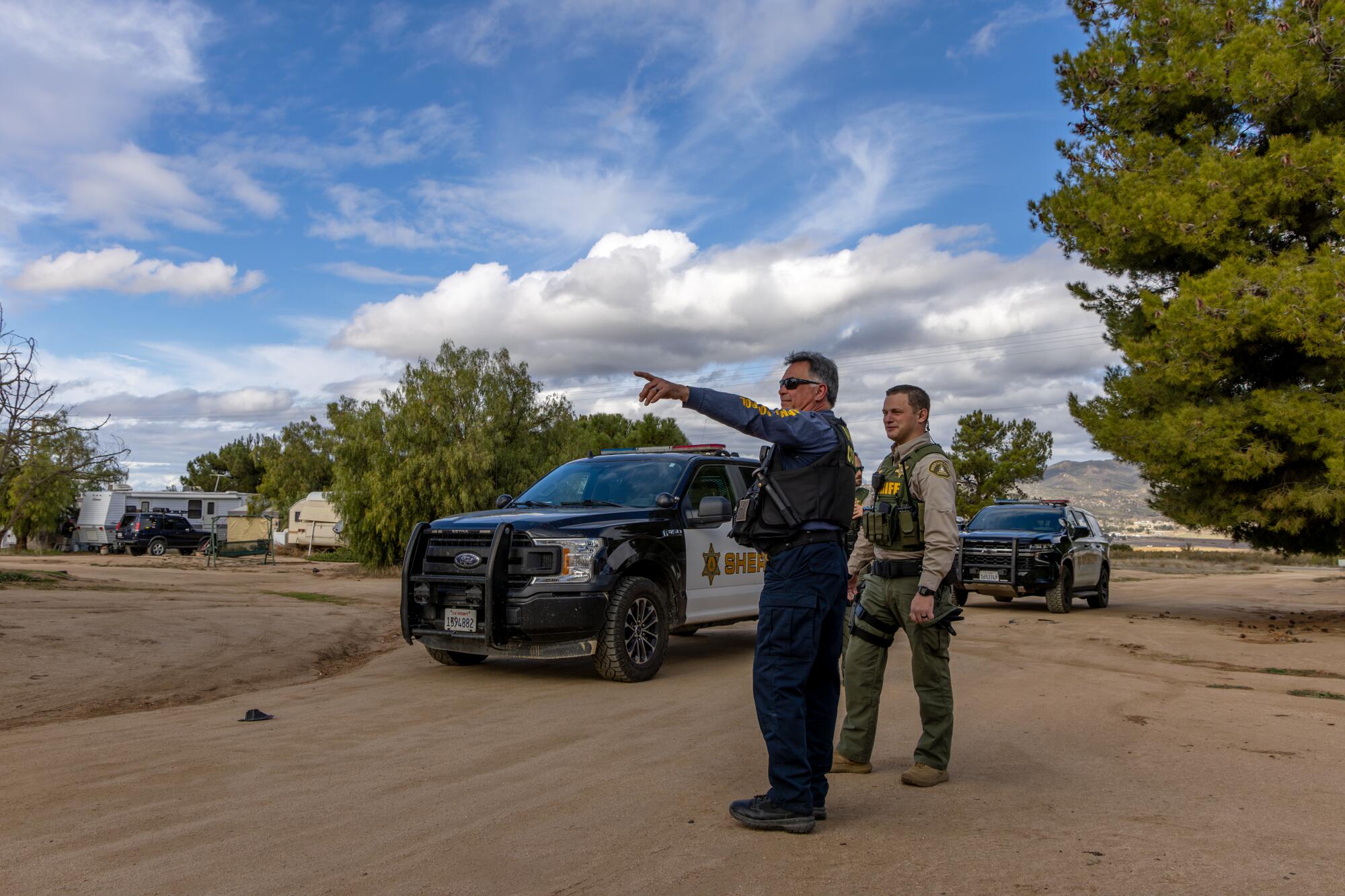
“For years we tried the straight-up enforcement route,” said the county’s animal control field services commander, Josh Sisler, who got in big trouble in the 1990s after doing a roundup of dogs that were biting children at bus stops.
“That was my first taste of politics,” he said. “People didn’t like their dogs getting scooped up. They liked the fines even less.”
But he’s come to learn that the better approach is one of communication and education. He said the biggest problem for animal owners in Anza and other remote areas is access to affordable veterinary care.
“Once they learned about the problems and were given opportunities” to spay, neuter and vaccinate, most people took charge, he said.
Unfortunately, it takes only a few bad actors — and a couple of breeding seasons — for problems to get out of control again, Beck said.

The animal control officer patrols a 361-square-mile area — a region that runs south from Hemet to the San Diego County border and east almost to Palm Springs. Finding, spotting or trapping free-roaming dogs here can seem futile at times.
Brush and bushes obscure hiding dogs, and two Cahuilla reservations run through his patrol area, making it impossible in some cases to follow dogs or find their owners.
“They just cross that road, and ‘poof’ they’re gone,” he said pointing to the Cahuilla land across the street.
Young, the Utah researcher, said that outside the United States there is a lot of research on the problem of free-roaming domestic dogs. Studies in Brazil, India and Italy suggest the effects on livestock and wildlife are significant. Researchers say there are at least 700 million dogs around the world, with 75% classified as free-roaming.
And it’s not just livestock that bears the risk. Free-roaming dogs have been known to attack wild animals too — including endangered species such as kit foxes and desert tortoises. They are also known to spread disease.
“We [tend to] think a lot of dogs might not have population-level impacts, but that’s probably not true when it’s an endangered species,” said Young, who noted that dogs don’t have to kill to hurt animal populations. Deer, for instance, face particular hardship if it’s “right before winter and they’re desperately trying to build up their fat, or at the end of winter when they’re barely making it, harassment from a pack of free-roaming dogs could make or break an animal,” she said.
Young saw the devastation to wildlife firsthand while doing research in Mongolia, where companion and working dogs often roam free. Their attacks on wild animals were gruesome, she said.
As domesticated animals, dogs lack the prowess and efficiency of wild predators, she said.
“Dogs don’t have all of that drive and all of that knowledge anymore,” she said. “Deep down they still have that genetic trait switched on when they attack. But they don’t have the skills and the learning from their parents like a wild wolf or coyote. And so it’s a much more traumatic experience for their prey.”
Dan Macon, a sheep rancher in the Sierra foothills outside Auburn, said it’s a problem that spans the state and is growing as more people move into that urban-wildlife or urban-agricultural interface.
“I don’t worry too much about coyotes, lions or black bears, but I do worry about domestic dogs,” he said.
In 2011, four of his sheep were killed by a neighbor’s dogs. It was the most brutal killing he’d ever seen. The animals were torn to pieces in what he described as a cruel, terrifying and likely very painful death.
“Used to be if your dog came on my property and hurt my animals, he’d get shot,” said Macon, who is also a natural resources advisor for University of California Agriculture and Natural Resources. “Everyone knew that.”
But that’s not the way things operate now. He said as people increasingly move into these rural areas from the cities and suburbs, they bring with them different cultural mores. They don’t shoot dogs.
In mid-December, an Anza resident named Chance — she declined to provide her last name — stopped her truck to speak with a Times reporter as she drove out of her driveway.
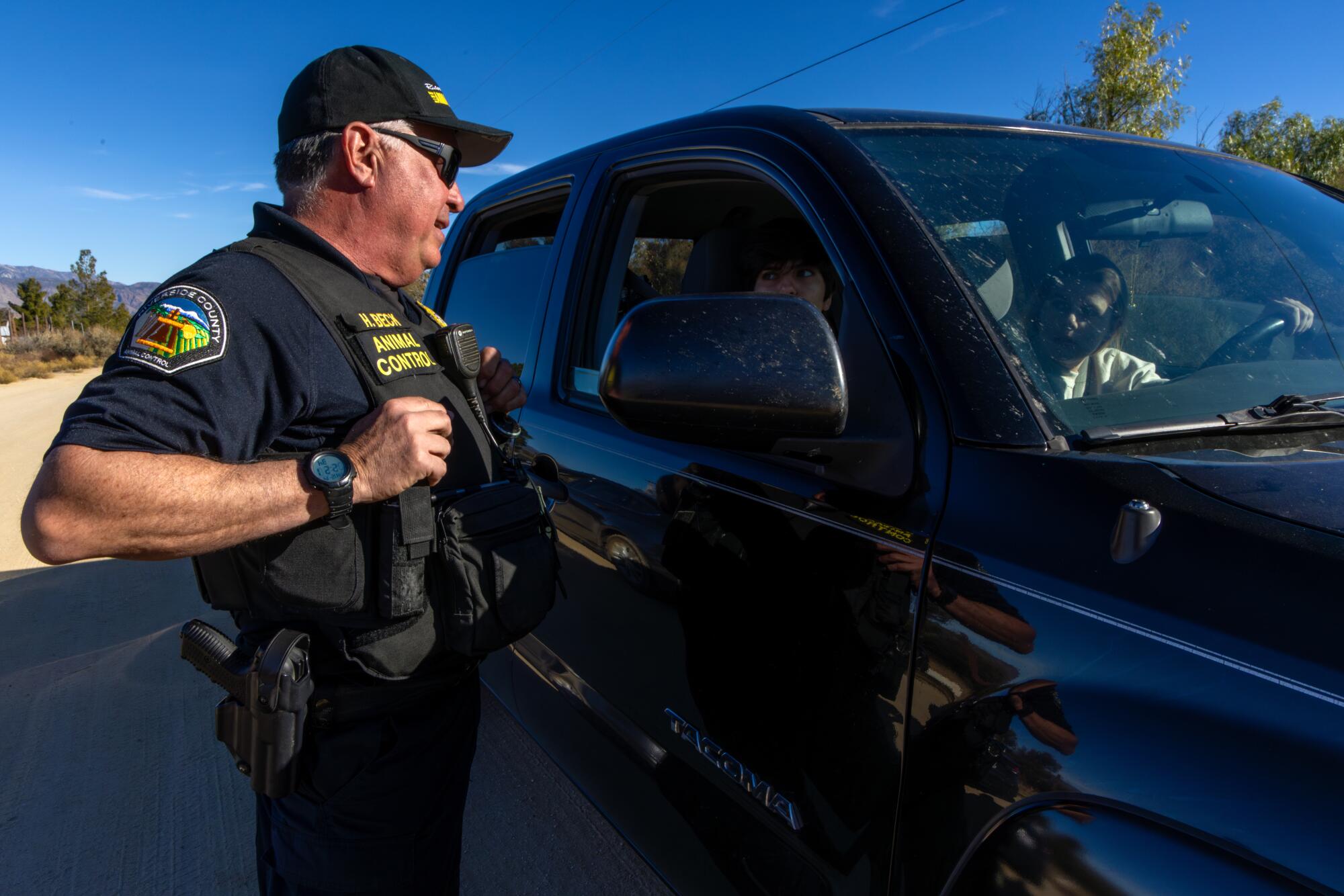
She said the dog problem has gotten so bad in recent years that she won’t walk along her road for fear of being attacked by “bush puppies.” She’s called Animal Services several times, but said they told her to shoot the marauding dogs.
“I don’t feel right doing that,” knowing they may be someone’s pets, she said.
When asked if shooting nuisance dogs was a common recommendation by animal control, Sisler, the Riverside County field commander, said no and expressed shock and incredulity that she had been told such a thing.
While it is legal to kill a dog if it’s on your property, he said, “we think there are better ways of addressing the problem.”
Beck, who is 60 and in his former life built custom guitars for rock stars, doesn’t see the dog situation getting resolved anytime soon.
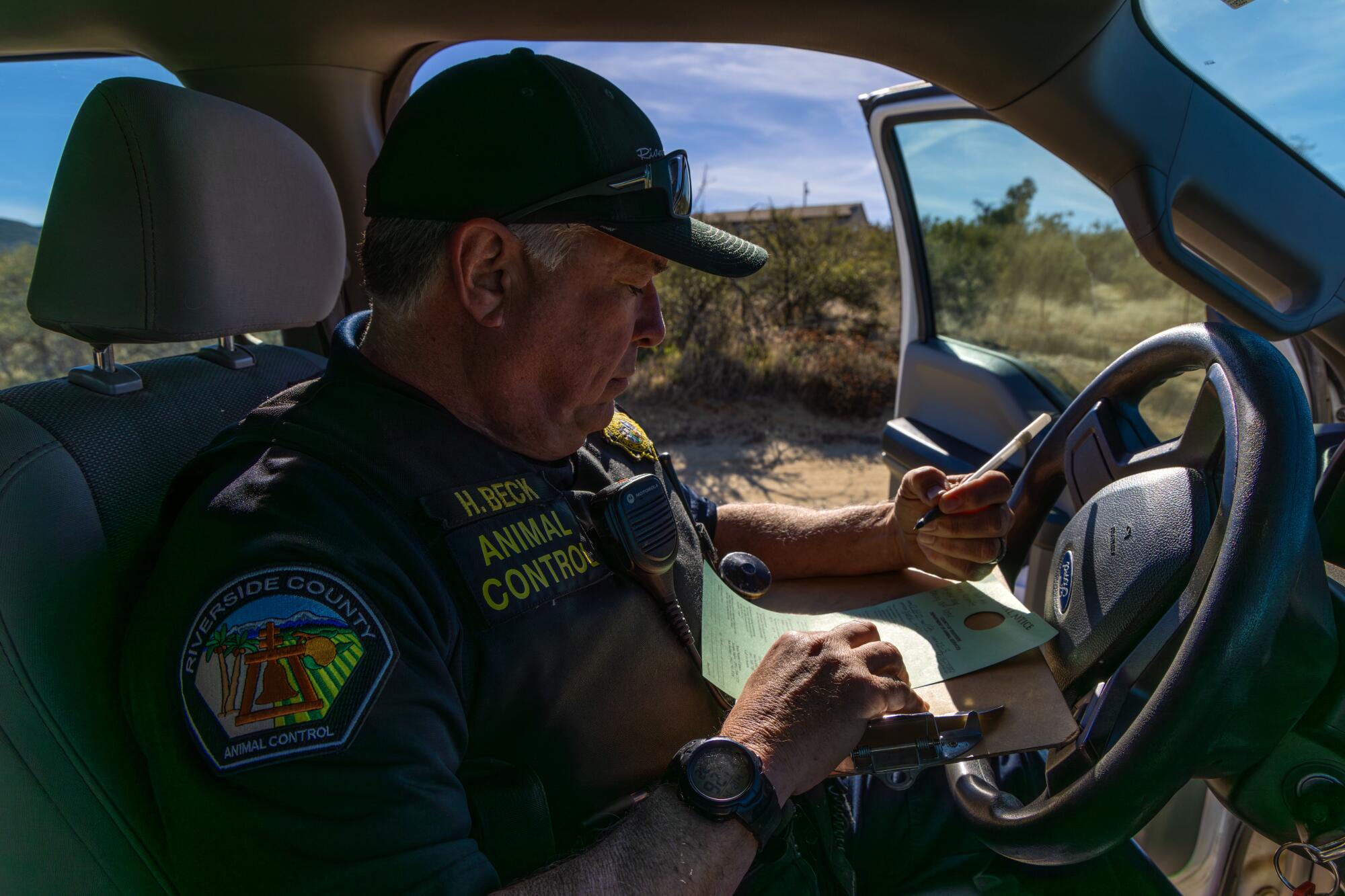
He said part of the problem is the place itself: Anza attracts people “who don’t want to follow the rules or laws. They think they can get away from that up here.”
And it’s because of this remoteness and laissez-faire attitude that people also come here to dump dogs they no longer want.
He knows this because he’s found several suburban and urban animals identified through microchips.
“Look around you,” he said, sweeping his hand out over the stark and uninhabited horizon. “What better place to do something like that? You just pull up, open the door and kick out the dog.”
Times staff writer Anthony De Leon contributed to this report.








